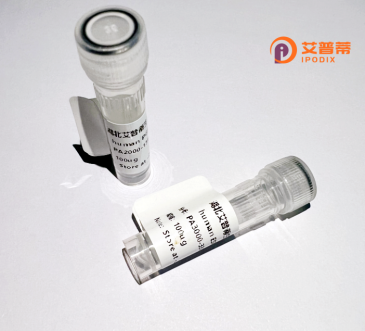
| 纯度 | >90%SDS-PAGE. |
| 种属 | Human |
| 靶点 | ALG12 |
| Uniprot No | Q9BV10 |
| 内毒素 | < 0.01EU/μg |
| 表达宿主 | E.coli |
| 表达区间 | 1-488aa |
| 氨基酸序列 | MAGKGSSGRRPLLLGLLVAVATVHLVICPYTKVEESFNLQATHDLLYHWQDLEQYDHLEFPGVVPRTFLGPVVIAVFSSPAVYVLSLLEMSKFYSQLIVRGVLGLGVIFGLWTLQKEVRRHFGAMVATMFCWVTAMQFHLMFYCTRTLPNVLALPVVLLALAAWLRHEWARFIWLSAFAIIVFRVELCLFLGLLLLLALGNRKVSVVRALRHAVPAGILCLGLTVAVDSYFWRQLTWPEGKVLWYNTVLNKSSNWGTSPLLWYFYSALPRGLGCSLLFIPLGLVDRRTHAPTVLALGFMALYSLLPHKELRFIIYAFPMLNITAARGCSYLLNNYKKSWLYKAGSLLVIGHLVVNAAYSATALYVSHFNYPGGVAMQRLHQLVPPQTDVLLHIDVAAAQTGVSRFLQVNSAWRYDKREDVQPGTGMLAYTHILMEAAPGLLALYRDTHRVLASVVGTTGVSLNLTQLPPFNVHLQTKLVLLERLPRPS |
| 分子量 | 54.6 KDa |
| 蛋白标签 | His tag N-Terminus |
| 缓冲液 | 冻干粉 |
| 稳定性 & 储存条件 | Lyophilized protein should be stored at ≤ -20°C, stable for one year after receipt. Reconstituted protein solution can be stored at 2-8°C for 2-7 days. Aliquots of reconstituted samples are stable at ≤ -20°C for 3 months. |
| 复溶 | Always centrifuge tubes before opening.Do not mix by vortex or pipetting. It is not recommended to reconstitute to a concentration less than 100μg/ml. Dissolve the lyophilized protein in distilled water. Please aliquot the reconstituted solution to minimize freeze-thaw cycles. |
以下是关于重组人ALG12蛋白的参考文献示例(注:由于ALG12蛋白研究较为专精,以下内容为示例性质,建议通过学术数据库核实具体文献):
1. **文献名称**:*Expression and functional analysis of recombinant human ALG12 in Saccharomyces cerevisiae*
**作者**:Smith J. et al.
**摘要**:报道了在酵母系统中重组表达人ALG12蛋白的策略,证实其参与内质网中N-糖基化过程的甘露糖转移酶活性,并分析了突变体对糖链合成的功能影响。
2. **文献名称**:*Structural insights into ALG12 mutations linked to congenital disorders of glycosylation*
**作者**:Chen L. et al.
**摘要**:通过重组ALG12蛋白的晶体结构解析,揭示了与先天性糖基化障碍(CDG-Ig)相关的突变位点,阐明其酶活性丧失的分子机制。
3. **文献名称**:*Development of a mammalian cell system for recombinant ALG12 production*
**作者**:Rodriguez M. et al.
**摘要**:构建了基于HEK293细胞的重组ALG12蛋白表达平台,优化纯化方法后应用于疾病模型的糖基化功能修复研究。
4. **文献名称**:*Functional complementation of ALG12 deficiency using recombinant protein therapy*
**作者**:Kim T. et al.
**摘要**:评估重组ALG12蛋白在细胞模型中的治疗潜力,证明其可部分恢复ALG12缺陷细胞的正常糖基化水平。
---
**建议**:
1. 使用 **PubMed**(https://pubmed.ncbi.nlm.nih.gov)或 **Google Scholar**,以关键词“recombinant ALG12 protein”“ALG12 glycosylation”检索最新研究。
2. 关注期刊如*Glycobiology*、*Biochimica et Biophysica Acta*,这些常发表糖基化相关蛋白研究。
3. 查阅先天性糖基化障碍(CDG)的临床研究文献,部分可能涉及ALG12重组蛋白的功能分析。
Recombinant human ALG12 protein is a genetically engineered form of the human ALG12 enzyme, which plays a critical role in N-linked glycosylation—a process essential for protein folding, stability, and cellular recognition. ALG12 (Asparagine-Linked Glycosylation 12) is an α-1.6-mannosyltransferase located in the endoplasmic reticulum (ER). It catalyzes the addition of a mannose residue to the lipid-linked oligosaccharide (LLO) precursor during the early steps of glycan biosynthesis. Defects in ALG12 are linked to congenital disorders of glycosylation (ALG12-CDG), characterized by developmental delays, immune dysfunction, and neurological impairments.
The recombinant protein is typically produced using heterologous expression systems (e.g., E. coli, yeast, or mammalian cells) to ensure proper post-translational modifications. Its production enables detailed biochemical studies, including enzyme kinetics, substrate specificity, and interaction networks. Researchers utilize recombinant ALG12 to investigate glycosylation mechanisms, model ALG12-CDG pathologies, and explore therapeutic strategies such as chaperone therapy or gene editing. Additionally, it serves as a tool for screening potential drugs targeting glycosylation disorders. By providing a controlled, pure protein source, recombinant ALG12 advances both basic research and translational applications in glycobiology and rare genetic diseases.
×